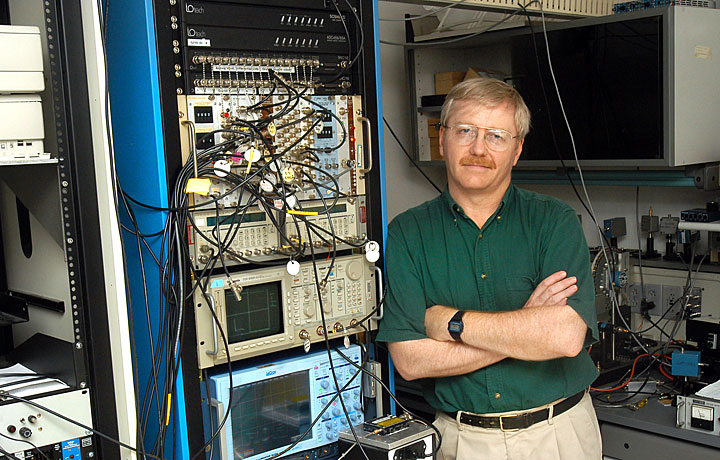Funding for New DOE Energy Frontier Research Center at Brookhaven Lab
Scientists will explore properties of "molten salts" with potential for use in nuclear energy applications
July 6, 2018
 enlarge
enlarge
Brookhaven Lab chemist James Wishart will lead a new DOE Energy Frontier Research Center focused on studying the properties of "Molten Salts in Extreme Environments" to inform possible applications of these materials in nuclear energy.
UPTON, NY—The U.S. Department of Energy (DOE) has announced funding for a new Energy Frontier Research Center (EFRC) to be led by DOE’s Brookhaven National Laboratory. The Brookhaven EFRC, named “Molten Salts in Extreme Environments,” will focus on understanding the properties of a class of materials with potential applications in energy technologies—particularly in nuclear power. It is one of 42 EFRCs announced by DOE that will receive a total of $100 million in Fiscal Year 2018 to accelerate the scientific breakthroughs needed to strengthen U.S. economic leadership and energy security.
“America’s continued energy security and global competitiveness will depend vitally on a sustained effort in science and discovery,” said U.S. Secretary of Energy Rick Perry. “By mobilizing the talents of our nation’s top scientists and forging them into powerful, pro-active teams, the EFRC program will help ensure America’s leadership in the development of critical energy technologies and innovations.”
Molten salts are materials composed entirely of positively and negatively charged ions that exist in a liquid state under elevated temperatures. The Brookhaven EFRC on Molten Salts in Extreme Environments (MSEE) will explore the structural and dynamic properties of these materials in the bulk and at interfaces with other materials to develop an understanding needed to predict and control their physical and chemical properties for a variety of applications. In nuclear energy, molten salts could be used as coolants for solid-fueled reactors, or as a material that acts simultaneously as a solvent and coolant for the nuclear fuel. Other potential applications include nuclear fuel reprocessing, metallurgy, batteries, and thermal collection, transport, and storage.
"Molten salts are attractive for use in nuclear reactors because they can operate at higher, more efficient temperatures while still at ambient pressure, and they have other safety and sustainability advantages."
— Brookhaven chemist James Wishart
“Molten salts are attractive for use in nuclear reactors because they can operate at higher, more efficient temperatures while still at ambient pressure, and they have other safety and sustainability advantages,” said Brookhaven Senior Chemist James Wishart, director of the new EFRC. “Our goal is to provide a scientific foundation for the practical implementation of molten salt reactors by understanding the chemical and collective behavior of molten salts and the materials dissolved in them (nuclear fuel and fission products) and how they affect the reactor materials that they contact (such as metal vessels and piping).”
Simon Pimblott of DOE’s Idaho National Laboratory will serve as deputy director; Shannon Mahurin of DOE’s Oak Ridge National Laboratory (ORNL) and Lynne Ecker of Brookhaven Lab will lead two major aspects of the MSEE mission. In addition to the three national laboratories, the partner institutions include Stony Brook University, the University of Iowa, and the University of Notre Dame. The project will receive a total of $11.75 million in funding over four years.
The team will use specialized tools—including Brookhaven Lab’s National Synchrotron Light Source II (NSLS-II), the Chemistry Division’s Accelerator Center for Energy Research (ACER), and the Spallation Neutron Source at ORNL—to explore how these materials behave at temperatures ranging from 400-800 degrees Celsius (752-1472°F) and while exposed to intense radiation. The project will advance these methods to enable real-time monitoring of structural and chemical changes and drive the development of advanced simulation and electronic structure calculations needed to understand the materials’ behavior.

One approach to studying molten salts as part of the new EFRC will be to use a combination of x-ray techniques at the National Synchrotron Light Source II (NSLS-II) to monitor the structure, chemistry, and morphology of these remarkable liquids under real world operating (operando) conditions. Combining these techniques to study, for example, the corrosion of materials in molten salts will provide a comprehensive view of the mechanism.
Established by the DOE’s Office of Science in 2009, the EFRC program brings together researchers from multiple disciplines and institutions—including universities, national laboratories, and nonprofit organizations—and combines them into synergistic, highly productive teams.
Brookhaven Lab also expects to play a role in another new EFRC to be led by Stony Brook University (SBU). John Parise, who serves as a joint appointee at Brookhaven, will serve as director of “A Next Generation Synthesis Center (GENESIS),” which will focus on accelerating the discovery of functional materials by integrating advanced in situ diagnostics and data science tools. DOE also renewed funding for the “Center for Mesoscale Transport Properties,” an EFRC led by Stony Brook University/Brookhaven Lab joint appointee Esther Takeuchi that was established in 2014.
NSLS-II and the Spallation Neutron Source are DOE Office of Science user facilities.
Brookhaven National Laboratory is supported by the Office of Science of the U.S. Department of Energy. The Office of Science is the single largest supporter of basic research in the physical sciences in the United States, and is working to address some of the most pressing challenges of our time. For more information, please visit science.energy.gov.
Follow @BrookhavenLab on Twitter or find us on Facebook.
2018-12996 | INT/EXT | Newsroom









